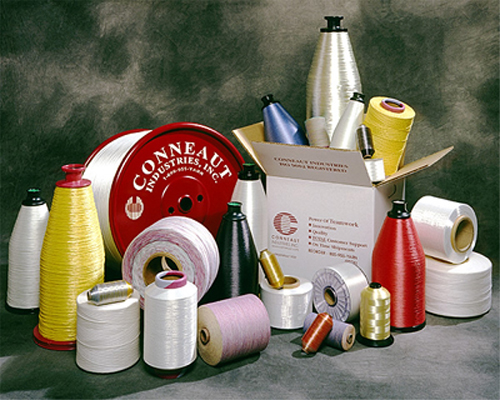- Bobbin – a plastic spool in which material is twisted or wound onto
- Tube – a cardboard tube in which material is twisted or wound onto, can be smooth or embossed
- Cob – a legacy term for a cardboard tube with embossing
- Serving Package – a double flanged plastic spool
- Put up – the package the material is delivered on.
- Winding – a process of converting single or multiple ends from supply packages into a precision way wind pattern for consistent runout in braiding process
- Twisting – a process of preparing one or more ends into a prescribed level of twist configuration. This is the first step before the plying process can begin. This process can be used to make flat materials more round.
- Plying – is the combining of individual yarns twisted together to make a composite yarn; a “two by three (2×3)” would mean that two single yarns of a construction of three are plied together to give the composite yarn of 2/3s from a total of six strands.
- Braiding – Interlacing several ends of fiberglass yarn in a manner such that the paths of the yarns are not parallel to the material axis offers repeatable processing characteristics. Braided materials are made into industrial sleeving and tubing products for electrical insulation applications and various reinforcements.
- Cordage – Multiple ends of textile twisted and plied into a larger very tight bundle
- Roving – These products are multiple ends of filament yarn processed onto high-capacity reels. The resulting bundle has less integrity than a cordage.
- DT – Produced similarly to a cabler in wire construction. Direct or Double twist of multiple ends to create a round fiber bundle with more integrity than a Roving but not as much as Cordage.
- PolyGlass Yarn – A combination yarn of Fiberglass and Polyester. Used for Magnet Wire covering. This combination yarn creates a flexible protective coating and capable of withstanding tough coil winding environments.
- Yield or Lineal Density – The way to describe the textile size. There are two systems used for presenting linear density, direct and indirect. When the direct method is used, the length is fixed and the weight of yarn is measured; for example, tex gives the weight in grams of one thousand meters of yarn. An indirect method fixes the weight and gives the length of yarn created. Traditionally, Fiberglass use yds/lb, and synthetics use Denier in the US and TEX in EU.
- Cotton Count – is specifically a way of describing the size of spun fibers and yarns. Cotton Count looks at one pound of the material and describes how many 840-yard lengths of spun fiber it contains
 Twist – A twist is mechanically applied to yarns to help keep all the filaments together. The twist is the number of turns about its axis per unit of length observed in a yarn or other textile strand. The level of twist expressed in turns per inch (tpi) of the yarn. The letter “S” or “Z” which indicates the direction of the twist. The S or Z direction of the yarn is determined by the slope of the yarn when it is held in a vertical position.
Twist – A twist is mechanically applied to yarns to help keep all the filaments together. The twist is the number of turns about its axis per unit of length observed in a yarn or other textile strand. The level of twist expressed in turns per inch (tpi) of the yarn. The letter “S” or “Z” which indicates the direction of the twist. The S or Z direction of the yarn is determined by the slope of the yarn when it is held in a vertical position.- Twist Balance– The orientation of twist in the plied yarn which will not cause twisting on itself when the yarn is held in the form of an open loop; all residual torsional effects are nullified.
- Sizing – The chemical coating applied to the surface of a fiberglass yarn. This is a necessity in being able to produce and manipulate fiberglass yarn. The sizing is applied during fiberizing to ensure a uniform coating of all the fibers. Some will also use this term when referencing the spin finish on a synthetic fiber. The sizing is proprietary to the various manufacturers, but have common uses and compatibilities.
- Spin Finish – The chemical coating applied to the surface of a synthetic yarn. The effect of these chemicals is mainly based on the formation of a thin but uniform layer, which covers the fiber surface and thus reduces surface friction and flexural rigidity of the textile material. The spin finish is proprietary to the various manufacturers, but have common uses and compatibilities.
The Conneaut spool has unique characteristics:
- Available up to 60 ends – Metered lengths (specified footage)
- Higher capacity spool/speed
- Improved breakaway design.



